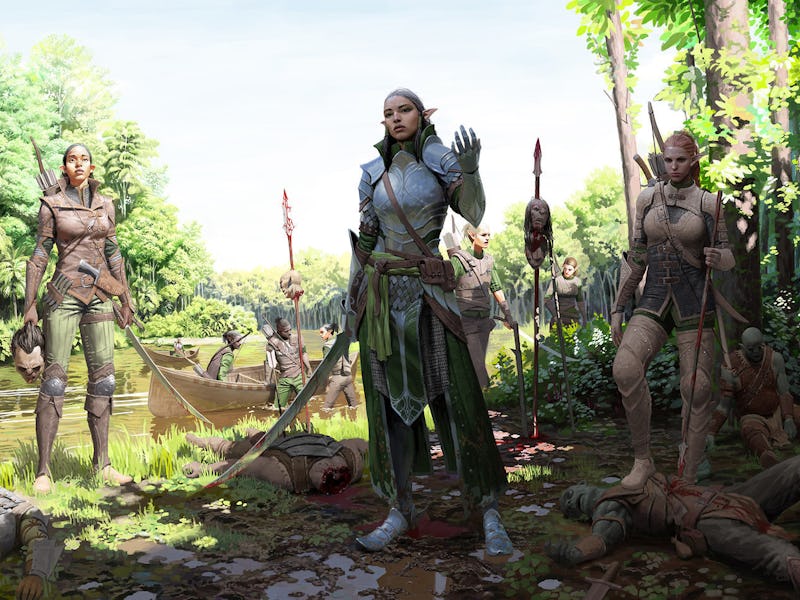The Best Way to Determine Your Moral Alignment, 'D&D' Style
Are you a chaotic neutral free spirit or a lawful good crusader?

Before Dungeons and Dragons was an amusing time waster for nerds, the cooperative board game was a lightning rod for controversy. It let players engage with an imaginative world in which many made-up religions existed, and the core ethical roadmap disturbed conservatives. Characters in the game are not simply good or evil, as many high fantasy worlds maintain — think of Christian-focused Middle-earth or Narnia — and instead, their motives are separated into sub-categories. Though the game’s use of (imagined) wizardry and monsters was certainly the main sticking point for hysterical Christians in the ‘70s and ‘80s, the moral alignment map certainly didn’t help.
Characters in Dungeons and Dragons have a natural stance on both chaos vs. order and good vs. evil. The original gameplay offered an in-world set of questions which players could answer as their characters in order to determine their alignment. In the original game, players could only choose between “lawful,” “neutral,” or “chaotic,” but in 1977 a game update added the concepts of good and evil. The only definition Dungeons and Dragons gives for “evil” is selfishness and disrespect for life, both of which are obviously up for interpretation.
According to the updated version of the Dungeons and Dragons handbook, lawful, neutral, and chaotic characters are defined in this way:
Law implies honor, trustworthiness, obedience to authority, and reliability. On the downside, lawfulness can include closed-mindedness, reactionary adherence to tradition, judgmentalness, and a lack of adaptability. Chaos implies freedom, adaptability, and flexibility. On the downside, chaos can include recklessness, resentment toward legitimate authority, arbitrary actions, and irresponsibility. Someone who is neutral with respect to law and chaos has a normal respect for authority and feels neither a compulsion to follow rules nor a compulsion to rebel. They are honest but can be tempted into lying or deceiving others if it suits him/her.
Similarly, the D&D handbook explains good vs. evil like this:
Good implies altruism, respect for life, and a concern for the dignity of sentient beings. Good characters make personal sacrifices to help others. Evil implies harming, oppressing, and killing others. Some evil creatures simply have no compassion for others and kill without qualms if doing so is convenient or if it can be set up. Others actively pursue evil, killing for sport or out of duty to some malevolent deity or master. People who are neutral with respect to good and evil have compunctions against killing the innocent but lack the commitment to make sacrifices to protect or help others. Neutral people are committed to others by personal relationships.
So, Who Are These “Types”?
The math of the moral alignment system puts everyone in the D&D world into nine types. Lawful good characters are sometimes called “crusaders,” neutral good characters are called “benefactors,” and chaotic good characters are “rebels.”
Neutral characters range from “judges” (lawful neutral), to “undecideds” (true neutrals, often animals or creatures), and “free spirits” (chaotic neutrals).
Evil characters are “dominators” (lawful evil), “malefactors” (neutral evil), and “destroyers” (chaotic evil, as in Joker’s “some men just want to watch the world burn”).
Moral Alignment in Pop Culture
The original quiz is available on the Wizards of the Coast website. Though it’s effective for D&D characters, its questions don’t really involve a modern understanding of ethics. Luckily for us, pop culture grabbed onto the moral alignment system, and organizing fictional characters into their alignments became somewhat of a meme.
People have done it to Star Wars characters.
Notice that Jabba the Hut — because he sometimes adheres to contracts and ignores them in other moments — is truly neutral evil.
Characters in The Walking Dead are an interesting fit, too.
This 'Walking Dead' alignment chart makes a case for chaotic characters of all three types being the most interesting to watch.
Weirdly enough, in the show, Eugene references the moral alignment system, saying, “Truth of the matter is, I’m not good. I’m not lawful, neutral, or chaotic. None of the above.” All of those distinctions would make him either neutral evil or true neutral — he’s supposed to be a nerd but somehow thinks he can remove himself from the lawful to chaotic spectrum, which is not accurate.
Game of Thrones, another show that prides itself on lots of dialogue regarding ethics, makes for an interesting moral alignment chart, too.
Here, the neutral characters across the good vs. evil spectrum are often the most interesting.